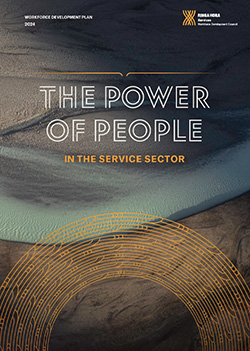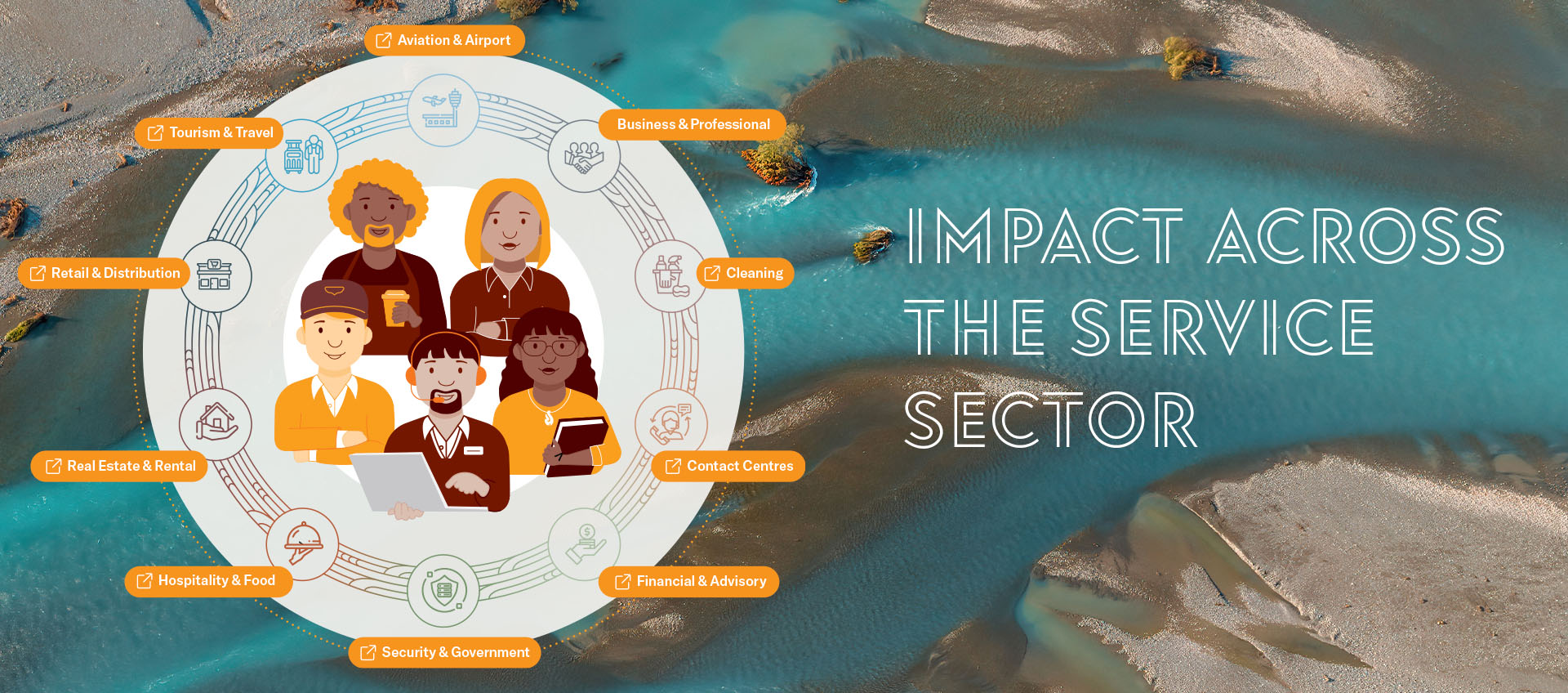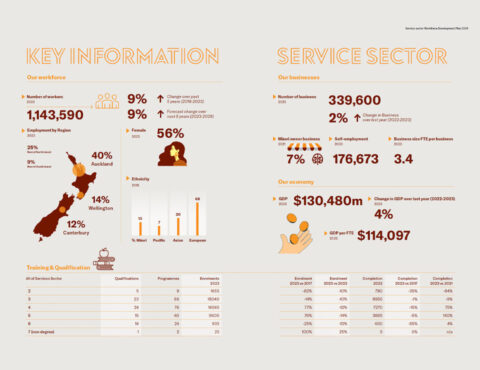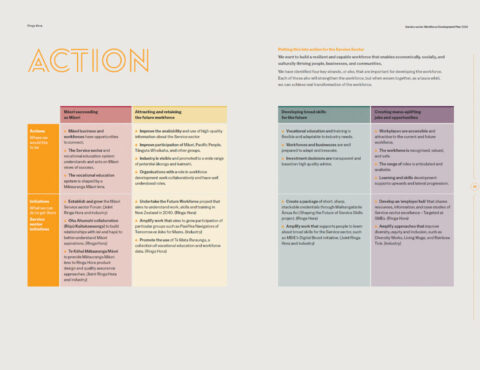
This year, the visual themes for our Workforce Development Plan and each of the Industry Action Plans have been developed with a Te Ao Māori context in mind.
The braided river, or awa ririki, is a powerful metaphor within Te Ao Māori, representing the interconnectedness and diversity of pathways that come together to form a unified whole, reminding us that despite individual differences, we are all part of a larger ecosystem that thrives on collaboration and shared purpose.
The Service sector is fundamental to Aotearoa and its people. Through millions of interactions a day, businesses across our sector advise, assist, and serve others. All Service sector industries have people at their centre. It is people who foster connections, helping others to navigate and meet the ever-changing needs of modern lives.
Workforce development plays a pivotal role in bolstering industry and creating a skilled and adaptable workforce that can effectively navigate disruptions and contribute to the overall sustainability of industries.


The Service sector is critical to New Zealand. New Zealanders rely on the Service sector to deliver public services, provide places to purchase everything from groceries to electronics, and create opportunities for us to connect with each other over a coffee or a meal.
But many businesses in the sector are currently doing it tough, with thin operating margins and job losses. Even long-standing, high-profile businesses are struggling to keep their doors open. With COVID-19 largely behind us and the economy slowly starting to turn around, there are some positive signs for the future, but the impacts of the past five years look set to persist.
People are at the heart of the Service sector, both as kaimahi and as customers. When people change, the sector needs to adapt to respond best to people’s needs.
The past five years have been a time of more disruption for many New Zealanders than any other time in recent memory. This has created a considerable shift in both the way we work, and what we value as customers. Rather than going back to “the way things were” in 2019, we’re facing a new reality in terms of the way people work, the things they value, and how they choose to spend their time and money.
Businesses that can adapt and respond to these changes will be best placed to thrive, both now and in the future. Some businesses are already rising to the challenge by doing things such as adopting new business models, identifying new opportunities, and attracting customers during off or shoulder seasons. The future of the sector will be bright if we can collectively tackle the challenges we currently face and seize the opportunities they present. This plan aims to:

There are a number of big shifts currently shaping the Service sector. Each of these is inter-related and impacts on businesses, the workforce, and customers. The combined effect of these shifts has created a challenging operating environment for businesses, but also provided motivation to do things differently.
Rapidly rising costs – The cost of doing business has risen significantly over the past few years with increasing rents, wage pressures, increased compliance, and soaring costs for many inputs ranging from milk to aviation fuel. At the same time, customers experiencing the cost-of-living crisis are spending less and being far more conscious when making purchasing decisions. The combination of rising costs and decreased spending has led to many businesses being squeezed out of the market.
Consumer preference – Cost pressures and people re-evaluating what’s important to them after COVID-19 have accelerated changes in consumer expectations and preferences. People are increasingly choosing offerings at a low price point or those that are more expensive but come with a higher level of service and boutique, tailored offerings. People are also being more deliberate about what they spend money on, with greater consciousness about consumerism, awareness of the impacts of purchases, and people wanting fewer “things” and more experiences.
Workforce expectations – People’s views about the role of work in their lives and what they expect from work and their workplace are changing. Many people are looking for work that aligns with their values, gives them purpose and supports their wellbeing, while also offering flexibility and working arrangements that suit their individual needs. Working remotely and conducting business virtually was necessary during COVID-19,
but it also showed that these different working environments were possible and preferred in many cases. New ways of working have also changed how people engage with services, including where they spend their money and how comfortable they are with engaging remotely. Businesses that can adapt to changing workforce expectations are more likely to attract the workforce they want, retain them for longer, and welcome them back if people take a break from work.
Technology – Technology has impacted the way that people engage with Service sector businesses and also the way that businesses operate. Cost and time-conscious customers have come to expect tech-enabled options to deliver fast and inexpensive options. The delivery of online services, from shopping to banking, has also changed how people engage with Service sector businesses. Businesses that can harness technology to deliver routine services can then free up kaimahi to focus on delivering great customer service to people who want or need something extra. In addition, if businesses use technology to do more back-office work, staff can then spend more time and energy focusing on interacting and connecting with people.
Changing demographics – The demographics of New Zealand’s population are dynamic, with significant shifts in characteristics, including ethnicity, age, gender roles and disability. This has implications for the Service sector, including who services are delivered for and by. It is becoming increasingly important that businesses reflect their workforce and customers, consider how their offerings respond to what different customers value, and are culturally aware. The wide range of people within the Service sector each make a unique contribution, and businesses benefit from being responsive to individual needs.

Some of the most critical skills a future ready workforce needs to have are:
Business skills – Many Service sector businesses are small, owner operated businesses run by people with a passion for delivering service but not necessarily formal skills around how to run a successful business. Investing in upskilling in these type of skills can help lift business performance and longevity.
Leadership skills – Good leaders can help improve productivity, performance and impact. Workplaces benefit from developing leadership at all levels and for people from all backgrounds, including Māori, Pacific and women. But even though there is wide recognition of the value of leadership, leadership skills often aren’t taught or deliberately developed. Businesses that actively nurture leadership skills are likely to see returns to the business, as well as wider benefits for individuals, customers and communities.
Customer service skills – Customer service has always been at the heart of the Service sector. As technology and cost pressures reduce the number of direct human interactions in the Service sector, the quality of those interactions becomes even more important. Having a workforce with great customer service skills, who can cater for a range of unique needs and tailor service accordingly, will give businesses an edge in an increasingly competitive market.
Digital and technology skills – The changing workplace has increased the need for digital and technology skills across virtually all roles within the Service sector. At a minimum people need to be comfortable engaging in a digital environment and working with technology, while there is also increased need for people with much higher level technology skills. Businesses that can lift the digital skills of their workforce, including those who aren’t comfortable engaging with technology, will be better able to adapt and take full advantage of opportunities as technology continues to evolve.
Alongside changing skill needs, there has also been a change in how people want to access training and skill development. Training provision needs to be responsive and adaptable to best meet the needs of the future workforce and workplace. In particular:
Ongoing upskilling – The traditional model in which people do most of their training before, or at the start of, their career is no longer relevant for most roles. As roles are rapidly evolving, people need to upskill throughout their careers. The training system needs to be set up in a way that enables and encourages people to continue to upskill.
Fit-for-purpose training – with work rapidly evolving, qualifications and training similarly need to evolve. The challenge is that some parts of the tertiary education system are not set up for the pace that is currently required. Increased speed to market and additional flexibility to meet individual business circumstances are needed. Otherwise, businesses are likely to disengage in formal training.
Micro-credentials and stackable learning – Workers and businesses are increasingly asking for bite-sized learning to meet the need for new skills or for skills to supplement training people have done previously. Micro-credentials are relatively new to New Zealand tertiary education and look set to be developed in a growing number of areas. The challenge for the system is to ensure that these are developed in a coherent way that meets business needs and also provides stackable building blocks and pathways for the people that undertake them.

The Service sector includes a huge variety of people in a wide range of businesses doing everything from working in airports, to selling houses, to cleaning buildings. There are a number of different industries within the Service sector, which are each distinct, but are also all interconnected.
The factors shaping the Service sector play out differently in different parts of the industry. Understanding these impacts will enable businesses and other industry groups to respond in ways best suited to their operating environment.
Sitting alongside this plan, we have developed a series of workforce development plans that focus on an individual industry within the wider Service sector. These plans provide information about the industry, articulate the challenges and opportunities that industry is facing, and outline actions that are specific to unique industry needs.
Transformational change in the Service sector workforce will take time, but to achieve that change, we need to start taking action now. The following plans include the key areas of focus, medium-term actions and short-term initiatives, and we have tracked our progress against these actions for 2024 and 2025.
Businesses in the Service sector are hugely diverse. Service sector businesses are found all across New Zealand, from our largest cities to our smallest towns. They range from sole traders to companies that employ thousands of people. Increasingly, there is diversity in business ownership with a growing number of Māori and Pacific-owned businesses.
While each business is unique, the thing that Service sector businesses have in common is that they have people at the centre. It is people who foster connections, helping others to navigate and meet the ever-changing needs of modern lives.
An estimated two out of every three New Zealanders work in the Service sector at some point in their careers. The sector currently has 1,144,000 people, approximately a third of the New Zealand workforce.
Māori represent 13% (148,000) of the total Services sector workforce.
Pacific peoples make up 7% (80,000) of the total Services Sector workforce.
Asian workers represent approximately 20% (230,000) of the Services sector workforce.
Tāngata Whaikaha workers represent 2.4% of the Services sector workforce. This is slightly lower than the percentage of the total workforce that identify as Tāngata Whaikaha (2.6%). However, we acknowledge that data on Tāngata Whaikaha is limited, and it is important that we create more growth opportunities within the sector for our Tāngata Whaikaha workforce.
Rangatahi (15–24-year-olds) represent more than 18% of the Services sector workforce. This number varies significantly between
each Service industry.
The backgrounds of those who enter the Service sector are diverse. Many who join the Service sector will be entering the workforce for the first time, others might be making career shifts from outside or within the Service sector, and some may stay within the sector. Most of the workforce can move quickly and easily between jobs. The most significant percentage of new entrants into the industry come from industry changers rather than tertiary or secondary education or otherwise, except for Hospitality Services, where the highest proportion comes from overseas.


Explore the Service sector workforce demographic, business, and economy statistics, and training and qualification data.

Even before the signing of Te Tiriti o Waitangi, Māori were adept entrepreneurs and had an eye for both business and overseas trade opportunities. In 2024 Māori business is critical to the New Zealand economy, as well as the Māori ecosystem of whānau, hapū, iwi and communities.
By 2030 the Māori population will likely exceed one million. New Zealand’s population is increasingly Māori, influencing culture, transformation, and showcasing the unique dimensions, culture, and worldview that Māori bring with them into every industry. Māori are projected to make up a larger share of the workforce, particularly the young workforce, over the next decade. It’s a future in which Māori industry can thrive and are empowered to determine their own direction. The innovation that has always been at the heart of the Service sector will be bolstered by:
Supporting the continuous evolution of Māori industry growth and success through workforce development is a vital aspect of enhancing Māori potential. This takes different forms across various parts of the Service sector. Māori within finance and advisory services can influence lending models and whānau financial aspirations within business, housing, and everyday financial transactions. Tourism is an avenue where Māori channel manaakitanga via person-to-person interactions and experiences as well as implementing tiaki taiao in natural environment experiences. Māori retailers are using online business models to meet increasing demand for Māori products that was not otherwise being met by mainstream retailers.
In the coming months, Ringa Hora will be releasing Tirohia ki Tua, a resource that weaves together the diverse impact of Māori in the Service sector. Dimensions of that impact can look like iwi and hapū caring for their own narratives, Māori creating and providing products for Māori,
or advocating for pākihi Māori access to business capital, knowledge and wealth building. The impact paints a picture of collective momentum among Māori that reaches into every corner of Te Ao Māori, built on mātāpono | Māori principles and uara | Māori values. It is matapono and uara that drive Māori in our industries to continue the momentum of legacy for our mokopuna today and in the future.

The Pacific population is growing rapidly and is New Zealand’s most youthful, with an average age of less than 25. This means that Pacific people are playing an increasing role in the Service sector, both in the workforce and as consumers. Businesses that can create pathways for young Pacific people and environments where they flourish will benefit from the huge potential that Pacific youth have to offer.
Pacific-owned businesses are thriving, both across the Service sector and New Zealand more widely. There is also a growing presence of Pacific individuals in leadership roles across mainstream businesses and those stepping up as role models. The Pacific leadership style emphasises leading by example, drawing from their upbringing that instils a sense of responsibility to serve and provide for others.
Pacific people bring a number of unique strengths to the workplace. These include:
In the coming months, Ringa Hora will release Kele’a—a resource designed for the Service sector, communities, educational providers, and organisations. Kele’a will showcase the Pacific workforce, their contributions, and aspirations in the Service sector by highlighting the value of Pacific workers, learners, and businesses. It will also present industry initiatives supporting Pacific workforce development and career advancement, along with tools and resources to advance a thriving Pacific workforce.

We want to build a resilient and capable workforce that enables economically, socially, and culturally thriving people, businesses, and communities.
We have identified four key strands, or aho, that are important for developing the workforce. Each of these aho will strengthen the workforce, but when woven together, as a taura whiri, we can achieve real transformation of the workforce.
To make this a reality, these Workforce Development Plans need to be driven by people who know the Service sector best – people like you.
We acknowledge and thank all the industry members, employers, Māori whānau, hapū, and iwi, Pacific people, Tāngata whaikaha, employees and learners who contributed their time and insights to these plans.
By continuing to work together, we can grow knowledge and understanding of the sector and its industries and create real change for the Service sector.